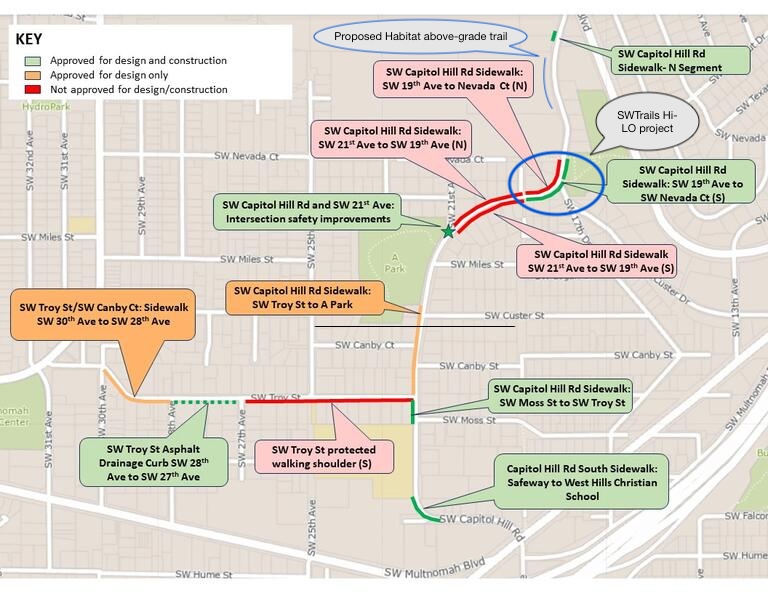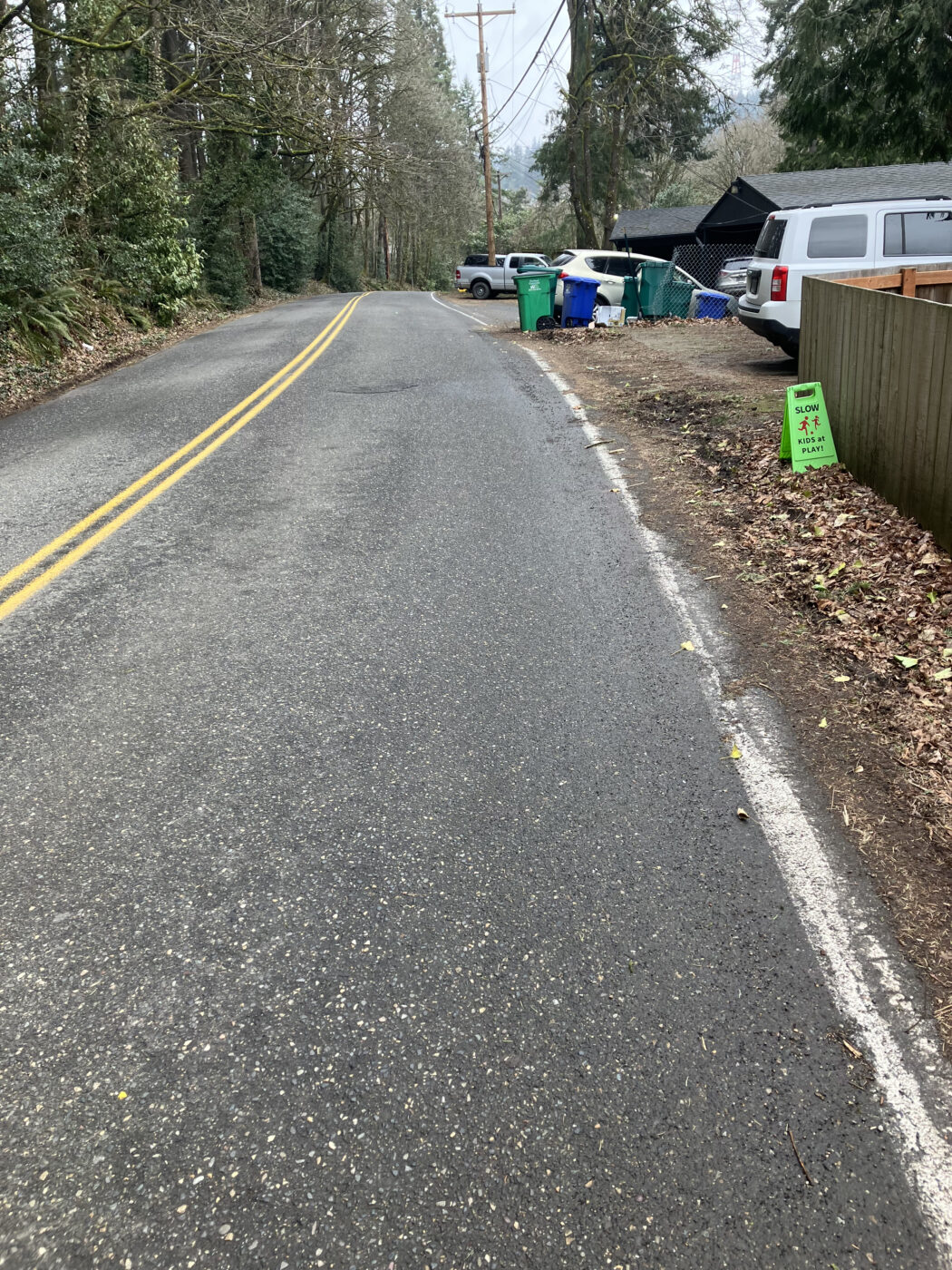 SW Capitol Hill Road, looking south, from the Habitat for Humanity frontage. (Lisa Caballero/BikePortland)
SW Capitol Hill Road, looking south, from the Habitat for Humanity frontage. (Lisa Caballero/BikePortland)
This post is by Guest Contributor Don Baack
As our city government reorganizes itself to operate more efficiently, there has been a lot of talk this past couple of years about silos. Bureaus as silos, silos within bureaus. But what’s happening right now on SW Capitol Hill Road takes silos to a new level of inefficiency. It also illustrates how the piecemeal way sidewalks and bike lanes get built in the southwest results in so many gaps.
The simple outline of the story goes like this…
A few years ago, SWTrails PDX, an organization I founded nearly 30 years ago, successfully lobbied state representatives Senator Wagner and Congresswoman Salinas to fund a new trail, the Hillsdale to Lake Oswego (Hi-LO) trail. The Hi-LO trail includes a segment along SW Capitol Hill Road, a busy neighborhood collector in the Hillsdale Town Center that has a few stretches of sidewalks near Barbur Blvd, but mostly lacks a safe place for people to walk.
State funds came through in 2021, and the Portland Bureau of Transportation (PBOT) planners were tasked with designing the new sidewalk segment between 19th Avenue and Nevada Court (segment 14 on the map above). After the usual rounds of public outreach, the planners decided it would sit on the east/south side of Capitol Hill Road, a placement which SWTrails supports.
 Map of PBOT sidewalk infill projects on SW Capitol Hill Rd. BikePortland annotations in blue. Source: PBOT.
Map of PBOT sidewalk infill projects on SW Capitol Hill Rd. BikePortland annotations in blue. Source: PBOT.
Meanwhile, north of Nevada Court, Habitat for Humanity acquired (also with state funding) a parcel of land from the Portland Bible Church which has about 400 feet of frontage on the west side of SW Capitol Hill Road. Habitat proposes to build 52 affordable housing units on the parcel.
City regulations call for a developer to build frontage improvements like sidewalks and bicycle lanes so that new development is accompanied by a supporting transportation network. The Development Review desk within PBOT oversees those public right-of-way requirements.
“The result is pedestrians walking in the street for the final 1,000 feet of dangerous road.”
But rather than requiring sidewalk and bike facilities that could possibly connect to PBOT’s Nevada Court work to the south, Development Review proposed a walking and bicycle path on private, Habitat for Humanity property—30 vertical feet above the street! The proposed path would dead-end about 300 feet north of the existing Nevada Court right-of-way. In other words, Development Review proposed a path which is up a steep hill, above the roadway, and does not connect to anything. Closing the 300 ft. gap between this proposed path and the nearest other right-of-way (SWTrail #3 and Capitol Hill Road) would require investment by either the City of Portland, the Portland Bible Church, or a future land purchaser. The connection, if built to existing bicycle route standards, would require about 300 feet (30 ft vertical at 10% grade) of steep grade from Capitol Hill Road.
So, to recap, on the same road one PBOT silo has designed infill sidewalk from the Safeway on Barbur Blvd to Nevada Court, while another PBOT silo (as part of code-required frontage improvements) is requiring a developer to build a public path on private property, above street grade—a path which will not connect to PBOT’s southern sidewalk infill projects. It’s not exactly the right hand not knowing what the left hand is doing, maybe the north and south hands?
The result is pedestrians walking in the street for the final 1,000 feet of dangerous road from Nevada Court up to the intersection of Capitol Hill Road with Bertha Boulevard.
 SW Capitol Hill Road, looking north. This shows the beginning of the 1,000 foot sidewalk gap north of Nevada Court (Photo: Don Baack)
SW Capitol Hill Road, looking north. This shows the beginning of the 1,000 foot sidewalk gap north of Nevada Court (Photo: Don Baack)
In response to neighborhood complaints, Habitat offered to contribute funding for a sidewalk on the east side of Capitol Hill Road, across the street from their property, in lieu of the above-grade path PBOT was requiring of them. An east side sidewalk would have partially filled the 1,000 foot sidewalk gap, and at least established a roadmap for future sidewalk infill on the northern third of Capitol Hill Road. PBOT responded with a firm no.
 Source: PedPDX sidewalk completeness tool.
Source: PedPDX sidewalk completeness tool.
This disjointed funding and implementation is why southwest Portland has so many gaps in its already paltry sidewalk network, and why the bicycle network is so incomplete. Unfortunately, this particular situation is not unique, similar scenarios play out all over our neighborhoods.
The City of Portland has neglected southwest sidewalk and bike infrastructure for half a century, even as the climate and pedestrian death crises have so visibly worsened in recent years. The reasons that the city doesn’t push developers to build sidewalks in the southwest are complicated, but if there is a root cause, it is our area’s lack of a formal stormwater conveyance system. We don’t have a Big Pipe (although we pay for it), our water runs off into creeks and streams.
Stormwater is too big a topic to go into in this short article, but we badly need representatives who understand the issue—let’s make learning on the job a thing of the past! We deserve better. Elections are coming up in seven months, our part of town needs representatives at all levels who know how to advocate for making our streets safer. And that means knowing something about transportation, development and stormwater.



